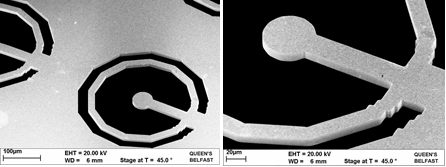Lead Organisation: Queens University Belfast
The purpose of this project is to develop an FSS to separate the 183 GHz channel from the 166 GHz channel in the MetOp-SG Microwave Sounder. At these frequencies the instrument provides global temperature and water vapour profiles for numerical weather predictions. They are closely spaced with an edge-of-band ratio of only 1.05, requiring state-of-the-art filter performance to separate. Current MWS instrument technology shows higher NEDT than required, and this project aims to demonstrate improved performance from ultra-low loss FSS.

The project set out the design of a Frequency Selective Surface (FSS) which simultaneously allows transmission of 175.3 – 191.3 GHz radiation and rejection of 164 – 167 GHz for TE waves, polarized at 45 incidence. The primary application for the FSS is in the microwave sounder (MWS) radiometer instrument on the MetOp second generation mission. This 24 channel instrument has a spectral span of 23 – 230 GHz, and provides measurements of temperature and water vapour profiles which are key data requirements for numerical weather prediction models. The aim of this work is to improve the sensitivity of the instrument by developing an ultra-low-loss FSS.
Project Outcome and Achievements
This project exploits computational electromagnetic modelling and advanced micromachining manufacturing capability that has been developed at QUB and established the feasibility of an FSS which can separate the 183 GHz and 165.5 GHz bands in the quasi-optical feed train of the MWS instrument. The FSS consists of three air spaced perforated screens with unit cells that are composed of nested resonant slots. Maximum transmission loss in the 183 GHz band is predicted to be < 0.45 dB and in the 165 GHz channel the reflection loss is <0.40 dB. For comparison, a waveguide diplexer currently used to separate the 183/165 GHz bands has a measured loss of 0.8 dB. Given the requirements for low insertion losses in the instrument, this study demonstrates performance improvements from the freestanding FSS design.
The measured results were combined with the predictions. Good agreement is observed, and the measured passband loss is shown to vary between 0.2 dB and 0.5 dB. In the reflection band the minimum and maximum measured losses are 0.2 dB and 0.75 dB. Generally the losses are very good across both the bands.
The FSS structure was fabricated using precision micromachining techniques. Silicon on Insulator (SOI) was used as the substrate material and Deep Reactive Ion Etching (DRIE) employed to pattern the top layer of the substrate with slots, and also remove the silicon under the slots. The structure was then coated with a high conductivity metallisation process.
In the course of this project, the team at QUB developed a low-loss FSS meeting the demanding requirements of the MetOp-SG MWS radiometer. A detailed numerical study established the optimum geometry, and the developed three-screen structure is shown to give a maximum insertion loss of 0.5 dB. FSS test results have demonstrated good agreement with predictions and the performance is in line with the specification across the passband, and across 80% of the reflection band. These results are significant as instrument designers now have proven hardware options at their disposal to cover a range of spectral filtering requirements. This work coincides with the bread boarding phase of the MWS QO network which is due to conclude in March 2015. The UK consortium consists of QUB, RAL Space, Airbus and QMUL.
